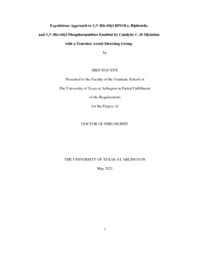
ATTENTION: The works hosted here are being migrated to a new repository that will consolidate resources, improve discoverability, and better show UTA's research impact on the global community. We will update authors as the migration progresses. Please see MavMatrix for more information.
Show simple item record
| dc.contributor.advisor | Jeon, Junha | |
| dc.contributor.advisor | Lovely, Carl J | |
| dc.creator | Nguyen, Hiep Hoang | |
| dc.date.accessioned | 2022-07-19T12:12:38Z | |
| dc.date.available | 2022-07-19T12:12:38Z | |
| dc.date.created | 2021-05 | |
| dc.date.issued | 2021-05-10 | |
| dc.date.submitted | May 2021 | |
| dc.identifier.uri | http://hdl.handle.net/10106/30758 | |
| dc.description.abstract | The research described in this dissertation is on two different projects namely i) Syntheses of 3,3’-bis functionalized BINOL and biphenol compounds, ii) Syntheses of 3,3’-bis silyl-BINOL-based phosphoramidites. The first chapter reports attempts at developing a unified strategy to access a range of 3,3’-bis-substituted BINOLs. This approach to access the 3,3’-functionalized BINOLs centers on the use of dioxasilines as a key intermediate generated through C-H activation catalytic reductive 3,3’-bis-silylation with a traceless acetal directing group. Dioxasilines successfully undergo nucleophilic addition to achieve various species of 3,3’-bis-silyl BINOLs with good yields. The scope is also expanded to a variety of silanes and biphenols. Furthermore, dioxasilines can also be subjected to Hiyama-Denmark coupling to accomplish 3,3’-bis arylation of BINOL. Moreover, 3,3’-bis-silyl BINOLs can undergo gold-catalyzed direct arylation which allows for further modifications. Despite multiple trials and modifications, arylations using previously mentioned methods did not produce adequate yields. More importantly, this adduct is subjected to stereoisomers analysis to confirm the circumvention of the racemization issue previously reported as one of the most common challenges of BINOL’s derivatization. This approach gives easy access to an array of 3,3’-bis-functionalized BINOL to be used in asymmetric syntheses. The second chapter describes the development of the strategy to access the 3,3’-bis-silyl-BINOL-based phosphoramidites. There are two reported methods to form phosphoramidite. The first bond formation (P-C or P-N) dictates the reagents and reaction conditions. This research finds that only the one of those two methods is applicable to our 3,3’-bis-silyl BINOLs. P-N bond initial formation followed by the addition of deprotonated 3,3’-bis-silyl BINOLs utilizes a milder condition, so the desilylation can be minimized. X-ray crystal structures of several resulted phosphoramidites are acquired to confirm the structures. This method creates a library of phosphoramidite ligands which has not been easily accessed before yet may have significant impact on stereoselectivities. | |
| dc.format.mimetype | application/pdf | |
| dc.language.iso | en_US | |
| dc.subject | BINOL | |
| dc.subject | Phosphoramidite | |
| dc.subject | 3,3’-bis-silyl BINOLs | |
| dc.subject | 3,3’-bis-silyl-BINOL-based phosphoramidites | |
| dc.subject | directing group | |
| dc.subject | Hydrosilylation | |
| dc.subject | C-H activation | |
| dc.title | EXPEDITIOUS APPROACH TO 3,3’-BIS-SILYL BINOLS, BIPHENOLS, AND 3,3’-BIS-SILYL PHOSPHORAMIDITES ENABLED BY CATALYTIC C–H SILYLATION WITH A TRACELESS ACETAL DIRECTING GROUP | |
| dc.type | Thesis | |
| dc.degree.department | Chemistry and Biochemistry | |
| dc.degree.name | Doctor of Philosophy in Chemistry | |
| dc.date.updated | 2022-07-19T12:12:38Z | |
| thesis.degree.department | Chemistry and Biochemistry | |
| thesis.degree.grantor | The University of Texas at Arlington | |
| thesis.degree.level | Doctoral | |
| thesis.degree.name | Doctor of Philosophy in Chemistry | |
| dc.type.material | text | |
| dc.creator.orcid | 0000-0001-7740-1484 | |
Files in this item
- Name:
- NGUYEN-DISSERTATION-2021.pdf
- Size:
- 7.467Mb
- Format:
- PDF
This item appears in the following Collection(s)
Show simple item record


